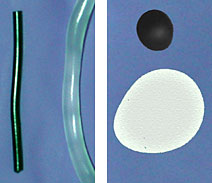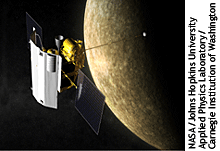|
August
13, 2004

[NIST
Tech Beat Search] [Credits] [NIST Tech Beat
Archives] [Media
Contacts] [Subscription Information]

Carbon
Nanotubes Eliminate Manufacturing Woe
 |
| Two examples of how nanotube-filled
polymers (thin rod in left photo; small disk in right photo)
avoid swelling seen in traditional polymers. |
Researchers
at the National Institute of Standards and Technology
(NIST)
have discovered that the addition of carbon nanotubes to a
common commercial polymer, polypropylene, leads to dramatic
changes in how the molten
polymer flows. This process eliminates a widespread manufacturing
headache known as “die-swell” in which polymers
swell in undesirable directions when passing through
the exit
port of an extruder (a machine for producing more or less continuous
lengths of plastic sections).
Researchers have been adding small amounts of nanotubes—tiny
tubes of carbon about 1,000 times thinner than a human hair—to
polypropylene in hopes of dramatically enhancing the material’s
strength and other properties.
Once realized, this enhanced polymer could be processed
at high speed through extruders for use in manufacturing.
NIST
materials scientists were concerned that because nanotubes
make
the polypropylene rubbery, the material would be difficult
to process or its enhanced properties would be lost. To
their
surprise,
the opposite proved true. When sheared (forced) between
two
plates, the polymer normally separates the plates. However,
when nanotubes are added, the plates are pulled together.
The
scientists discovered that this “pulling-together”
completely alleviated die-swell. Industry currently uses various
time-consuming trial-and-error solutions to deal with the problem.
Eliminating
die-swell should help manufacturers improve their time-to-market
by simplifying their die design processes and enabling
the controlled
manufacture of smaller components.
The
NIST work appears in the August 2004 edition of the journal
Nature Materials.
Media
Contact:
Scott
Nance, scott.nance@nist.gov or (301) 975-5226


Going
to Mercury? Don’t Leave Home Without a NIST Calibration
 |
| Artist’s
impression of the MESSENGER spacecraft in orbit around
Mercury. |
T
he first spacecraft intended to orbit Mercury was launched
on Aug. 3, 2004, carrying an instrument for mapping
the composition
of the planet’s crust that was calibrated with a novel
procedure at the National Institute of Standards and Technology
(NIST). The procedure, using NIST-produced, high-energy gamma
rays, enabled the device to be prepared for the same intense
radiation levels typically produced
in outer space.
Mercury
is a rocky planet like the Earth but smaller, denser and with
an older surface. Scientists believe that by studying Mercury
they can develop a better understanding of how the Earth formed,
evolved and interacts with the Sun.
Scheduled
to orbit Mercury in 2011, the National Aeronautics
and Space Administration's (NASA)
MESSENGER (MErcury Surface, Space ENvironment, GEochemistry,
and Ranging)
spacecraft carries seven scientific instruments, including
a detector that will measure gamma rays emitted by Mercury’s
crust as it is bombarded by cosmic rays. The bombardment
releases
neutrons, which react with the elements in the crust; analysis
of the resulting gamma rays will help identify the elements.
The detector’s efficiency (the fraction of incoming
gamma rays detected) needed to be calibrated based on
the
gamma-ray energy for 37 different orientation angles associated
with the orbits around the planet. Typical gamma ray sources,
such as those used for medical treatments, emit at lower
energy levels than those needed for the calibration.
NIST scientists, in collaboration with the mission’s
prime contractor, the Johns Hopkins University Applied Physics
Laboratory, solved the calibration problem by using a high-intensity
neutron beam to irradiate targets made of sodium chloride
and chromium. The targets captured neutrons and emitted gamma
rays, which were measured by MESSENGER’s gamma-ray
detector. These gamma rays spanned the energy range that
will be measured
in the planetary assay. According to Johns Hopkins’
Edgar A. Rhodes—lead
scientist for the MESSENGER
instrument—the
calibration procedure “will
likely set a new standard for space-flight gamma-ray spectrometers.”
Media
Contact:
Laura
Ost, laura.ost@nist.gov or (301) 975-4034


New
NIST Guide Helps Book’em on Digital Evidence
Criminal
investigators increasingly find that personal computers,
handheld devices and even mobile phones contain pictures,
e-mail and other data critical to the prosecution of cases.
A new guide written by computer forensics experts under
the direction of the Office of Law Enforcement Standards
(OLES) at the National Institute of Standards and Technology
(NIST) provides step-by-step instructions to assist investigators
in locating digital evidence so that it stands up to scrutiny
once cases are tried.
Forensic
Examination of Digital Evidence: A Guide for Law Enforcement is the second guide published since NIST was
asked in 1998 by the National Institute of Justice (NIJ)
to work on computer forensics.
At the request of NIJ, NIST recently convened a panel of
computer forensics experts that pooled their expertise to
shape the content of the new guide. NIST staff then organized
the information into an easily understood and highly usable
document.
The
guide provides practical techniques for extracting digital
data without
either inadvertently altering the information
or making it appear that it has been altered. For example,
one section describes the right type of search warrant to
access the data. Another lesson explains how data must be
extracted without changing “modified dates” or
other record fields that may lead to charges of evidence
tampering.
Other topics covered in the publication include securing
digital evidence, hardware/software operating systems, physical
access, internal or external storage devices, and the retrieval
of configuration information.
The guide can be downloaded in ASCII text and Adobe Acrobat
(pdf) format from the NIJ Web site. Go to www.ojp.usdoj.gov/nij/pubs.htm
and enter publications number NCJ 199408 into the search
engine.
Media
Contact:
Scott
Nance, scott.nance@nist.gov or (301) 975-5226


Plan
to Reform, Strengthen NIST MEP Announced
On
Aug. 9, 2004, Commerce Under Secretary for Technology
Phillip
Bond announced the Commerce Department’s approach to
reform and strengthen the Manufacturing Extension Partnership
(MEP), managed by Commerce’s National Institute of Standards
and Technology (NIST) in close cooperation with state and
local
organizations. The improvement plan is based on input from
MEP partners and others at nine webcasts and meetings held
around
the country over the past month, as well as discussions with
other federal agencies and Congress.
MEP
is a nationwide network of resources helping small manufacturers
become more competitive.
The
improvements are a key step toward meeting the goals
set by Commerce Secretary Don Evans in a report on manufacturing
released earlier this year. (Manufacturing in America:
A Comprehensive Strategy to Address the Challenge to U.S.
Manufacturers
is available at www.manufacturing.gov.)
As
a result of feedback from MEP partners and others, the Commerce
Department will use a reapplication process to strengthen the
performance of MEP centers. Reapplication will take place as
part of the current review process for MEP centers rather than
as a separate effort.
External
teams review an MEP center’s performance every two years
as required by statute. In addition to independent reviews every
two years, NIST currently reviews center performance quarterly.
Providing for probation periods and termination for underperforming
centers, the process has a robust system of oversight and program
management and helps ensure that all MEP centers are operating
at a high level.
Several
additional reforms to increase the efficiency and effectiveness
of the MEP program also are planned, including a robust strategic
planning process, closer coordination with other agencies,
new
technology services, and an integrated knowledge management
system.
The complete
text of Under Secretary Bond’s statement on the MEP program
may be found at www.technology.gov/speeches/PJB_040809.htm.
Media
Contact:
Jan
Kosko, janice.kosko@nist.gov or (301) 975-2767

Forum
on Vehicle Scale Shipment Accuracy
The National
Institute of Standards and Technology (NIST) is sponsoring
a forum on laws and regulations relating to commercial transactions
that rely on net weights of commodities and/or service charges
determined by vehicle scales. The free conference, to be held
Sept. 28, 2004, from 10 a.m. to 4 p.m. at the U.S. Department
of Commerce in Washington, D.C., will look at how truck cargo
weights are determined. Such weights are calculated by subtracting
a truck’s weight when full from its empty weight as
recorded from previous measurements. However, additional material
in the truck cab, new tires, or even mud and dirt can make
the weight previously assigned to a delivery truck incorrect.
Over time faulty calculations can boost or reduce the actual
weight of total deliveries by thousands of pounds.
Industry
representatives, consumers, scale owners and users, exporters,
importers, retailers, federal and state representatives are
invited to participate in the forum. Space is limited. Advanced
registration is required. The registration deadline is 5 p.m.
EDT, Sept. 1, 2004. Further information is available from
Conference Coordinator Tom Coleman at t.coleman@nist.gov or
(301) 975-4868.
Media Contact:
John
Blair, john.blair@nist.gov or (301) 975-4261

NIST
Assists Penn in Nano Breakthrough—University
of Pennsylvania researchers recently relied on images
produced
at the National Institute of Standards and Technology (NIST)
to achieve a significant advance in materials science
reported
in the Aug. 12, 2004, issue of the journal Nature. The
Penn team used transmission electron microscopy at
NIST to define
the arrangement of wedge-shaped molecules that
could be used in the design of selective and stable artificial
membrane pores for applications in filtration, medicine,
nanomanufacturing and sensors. For the full journal article,
see www.nature.com/cgi-taf/DynaPage.taf?file=/nature/journal/v430/n7001/full/nature02770_fs.html.
September
Event Focuses on Biometrics—The Biometrics
Consortium Conference 2004, scheduled for Sept. 20-22,
2004,
at the Hyatt Regency Crystal City in Arlington, Va., will
showcase recent advances in technologies and address
issues
facing the biometrics industry and end users in a variety
of areas, including homeland security, law enforcement,
identity theft and interoperability. Featured speakers
include Asa Hutchinson, under secretary for border
and transportation
security at the Department of Homeland Security; James
Woolsey, former director of Central Intelligence;
and David M. Wennergren,
chief information officer for the Department of the Navy.
Details and online registration are available at www.nist.gov/bc2004.
Baldrige
Award Winners Go on the Road—Senior leaders
and others from 12 organizations that have received the
Malcolm Baldrige National Quality Award will share their
exceptional practices at conferences in Oak Brook, Ill.,
on Sept. 10, 2004, and San Antonio, Texas, on Sept. 30,
2004. They include five of the seven 2003 recipients of
the award: Medrad Inc. (manufacturing category), Caterpillar
Financial Services Corp. U.S. (service), Stoner Inc. (small
business), Community Consolidated School District 15 (education),
and Saint Luke’s Hospital of Kansas City (health care).
For more information and online registration, go to http://baldrige.nist.gov/2004_Regionals/index.html.


(Return
to NIST News Page)
Editor:
Gail Porter
Date
created: 08/13/04
Date updated:08/13/04
Contact: inquiries@nist.gov
|

